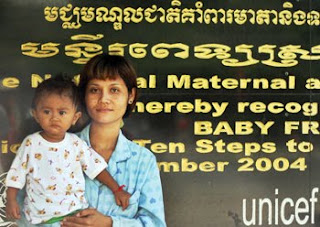Photo by: Sovan Philong
Bun Seilla, 28, and her 1-year-old son, San Soben, at the National Maternal and Child Health Centre in Daun Penh district yesterday.
Bun Seilla, 28, and her 1-year-old son, San Soben, at the National Maternal and Child Health Centre in Daun Penh district yesterday.
via CAAI
Wednesday, 08 September 2010 15:04 Brooke Lewis and Mom Kunthear
THOUGH considerable gaps remain between poor and wealthy families when it comes to child health, experts yesterday said they were optimistic that Cambodia could meet the Millennium Development Goal pertaining to child mortality.
The global goal calls for the baseline rate of 124 deaths per 1,000 live births to drop to 41 by 2015. To meet a nationalised version of the goal, the rate would need to fall to 66 deaths per 1,000 live births.
A report released yesterday by the NGO Save the Children said national progress towards the goal had not been spread evenly across socioeconomic groups, and indicated that Cambodia was off-track to meet the global goal.
Sharon Wilkinson, country director for Care International in Cambodia, said that while she hadn’t read the report, she agreed with its central contention that economic growth had affected different wealth brackets differently.
This, in turn, may have contributed to a rising gap in the rate of child mortality for the country’s richest compared to the country’s poorest, she said.
“While as a country infant mortality is decreasing, and that is a good thing, the 20 percent living in poverty, that lowest quintile, are still not surviving,” she said.
She said the overall decrease could be attributed to “a multitude of factors”, including the expansion of educational opportunities for women and access to clean water and the extension of immunisation and family planning services.
Linking the child mortality rate to the maternal mortality rate, which for Cambodia has remained stubbornly high, she said further decreases could be contingent on an expansion of emergency obstetric care.
“There is certainly a correlation between maternal mortality and child mortality,” she said. “We need to see a lot more political will and resources directed toward emergency obstetric care.”
Addressing the child mortality goal generally, she said, “We can reach it, but it will take enormous political will and commitment.”
Viorica Berdaga, chief of UNICEF Cambodia’s Child Survival Programme, was even more optimistic with respect to the national goal of 66 deaths per 1,000 live births. “For sure Cambodia will meet this MDG, and depending on the success of the programmes Cambodia plans to implement, they might achieve it with equity,” she said.
But Ou Kevanna, manager of the National Nutrition Programme at the Health Ministry’s National Maternal and Child Health Centre, acknowledged that it would be difficult to overcome inequalities between the wealthy and the disadvantaged.
“There is always a gap between the rich and the poor because the rich can find good professional health officials or go to the hospitals with modern medical things, but the poor people cannot,” he said.
When asked about Cambodia’s prospects for reaching the child mortality MDG, he said: “I expect that Cambodia will reach the goal to reduce child mortality in 2015, but the Health Ministry cannot do it alone. We need cooperation from the relevant institutions, pregnant women and local authorities.”


No comments:
Post a Comment